|

01-22-2009, 06:43 PM
|
 |
Rank: Light Heavyweight
|
|
Join Date: Jul 2005
Location: Trinity University, San Antonio, Texas
Posts: 4,794
|
|

Ok, so I am Case Study #2 here in terms of body posture. I do not suffer from any aches and pains but this is EXACTLY how my body looks: http://robertsontrainingsystems.com/...+Eric+Cressey/
I am gonna quote the recommendations for this person:
By strengthening the gluteus medius, minimus, and maximus, he could likely shift some of the burden off of his quadriceps and patellar tendon, alleviating some – if not all – of his pain. Some extra work for the vastus medialis and dorsiflexors, coupled with stretching and myofascial release of the ITB/TFL, calves, and peroneals are highly recommended as well. Obviously, given his excessive anterior pelvic tilt, a lot of work needs to be done on strengthening the core and loosening up the hip flexors, hamstrings, and erector spinae as well.
Even though there's currently no pain in the shoulders, this may not be the case down the road. Specific strengthening of the scapular retractors and depressors is needed, coupled with concomitant lengthening of the internal rotators (pectoralis major, latissimus dorsi, teres major, anterior deltoid and subscapularis) and scapular elevators (upper trapezius and levator scapulae).
Even though the left clavicle and scapula are elevated, they appear otherwise symmetrical in shape/tonus to the right side. This indicates the problem is farther down in the kinetic chain. The forward head posture should be addressed using activation work for the deep neck flexors, coupled with stretching of the suboccipitals and sternocleidomastoid (SCM) (and the levator scapulae, as noted earlier).
Like our first client, he needs the whole package, as it's impossible to isolate within a kinetic chain with so many glaring dysfunctions. That said, the client's pseudo-scoliosis-like unilateral deficits merit special considerations that focus on unilateral training.
In addition to the aforementioned focus on glute-strengthening/activation, these modifications should include right QL stretching (e.g. standing or seated side bend stretches), with QL activation work on the left hip side (e.g. side bridges and side hip thrusts). Specific focus in stretching should also be emphasized with respect to the left thoracic and right cervical erector spinae.
Numerous other compensations occur, resulting in tightness and weakness through the kinetic chain from head-to-toe. As such, it's best to assess these functional decrements individually with tests of range of motion and strength. If conservative measures fail (and there is in fact a pseudo-scoliosis), the client would be wise to visit a qualified orthopedist to determine if:
A) an overactive QL is indeed the cause of the problems.
B) an actual structural leg-length discrepancy (possibly requiring an orthotic) is present (they're not as common as people think).
C) the curvature is structurally-based at the spinal level (i.e. vertebral shape or positioning).
Guess I have to get to work now...
__________________
To view links or images in signatures your post count must be 10 or greater. You currently have 0 posts.
To view links or images in signatures your post count must be 10 or greater. You currently have 0 posts.
|